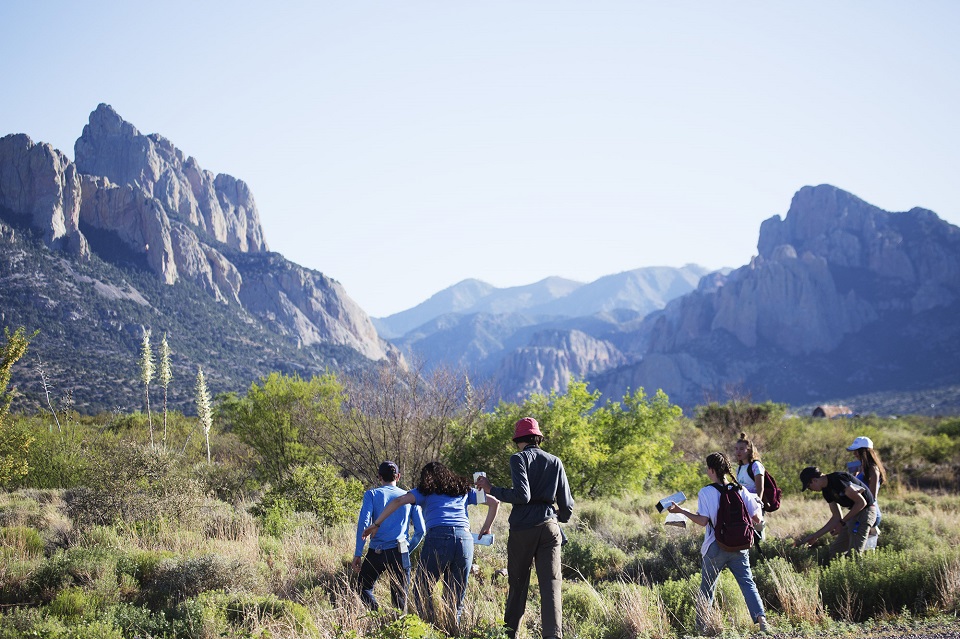STEM Outreach, STEM Research Grants
Seven days of SANITY in the Chiricahua Mountains

How does a student go from “I hate bugs, I hate being outside and I hate being dirty,” to petting a lizard, watching nectar-feeding bats just three feet away and taking soil core samples? Jeremy Jonas, an educator at Tucson High Magnet School in Arizona, seems to have found an answer. Now in his 11th year of teaching, he instructs 10th-12th graders in biotechnology and advanced research methods. Jeremy is also the director of the school’s summer research program, called Science and Nature in Tandem for Youth (SANITY), held at the Southwestern Research Station in Portal, Arizona. In 2019, Jeremy received a $5,000 STEM Research Grant from the Society to procure new equipment for his classroom lab and fund student transportation to SANITY.
Jeremy has a background in ecology and evolutionary biology, with a focus on the genetic basis of coat color variation in mammals. He has also worked in several labs, providing him with the expertise he needs to assist his students with microbiology, molecular biology and ecology-focused projects. “Thanks to the STEM Research Grant, we now have new equipment to build larger scale projects that require infrastructure construction,” Jeremy said. “With our suite of power tools and construction equipment, we have made new mister watering systems for a seed ball restoration project in our green house, a new compost system in our school garden for several student projects investigating the microbial contribution to composting systems as well as the installation of a homemade cabinet system in a closet to act as a new grow chamber for a project involving the culturing of microbial fungus.”

The grant also supported transportation for 17 students’ attendance to SANITY in 2019. SANITY introduces participants to professionals in the fields of ecology, ornithology, entomology, astronomy and more through authentic hands-on research opportunities in the Chiricahua Mountains. Grant funds were used specifically to rent three minivans to transport students to the Southwestern Research Station and back. Without transportation, the students would not have had the opportunity to participate.
Over the course of a week, students work side by side with scientists in all of these fields and finish the program with an independent research project. They then present their research at the field station and at a community potluck with family and friends when they return to Tucson. “This program empowers students to think critically, test their questions and ideas about nature and feel confident in communicating their science to an audience,” Jeremy noted. “The impact of this opportunity is truly invaluable. Many of this year’s participants have never spent this much time outdoors and certainly have not conducted research in the field.”
One of Jeremy’s students, who unambiguously expressed her reluctance in participating in SANITY, can speak to just how transformative seven days spent immersed in STEM can be. When first approached to apply, she had two words for Jeremy: “no way.” After some encouragement from both Jeremy and her cousin who signed up, she was persuaded. It also helped that Jeremy was able to cover the transportation costs associated with attending with the STEM Research Grant. “I have had the extreme pleasure and honor of watching this student confront her fears, her socioeconomic barriers and navigate spaces where most people don’t look like her. This grant helped me offer these opportunities that will last a lifetime. The hope is that the experience will encourage these students to pursue science in their remaining years of high school as well as potentially college and careers!”

For other teachers working with limited resources, Jeremy believes there is no greater resource than a school’s local community of scientists. While he has been fortunate to be near the University of Arizona, Jeremy has also leaned into networks of countless local scientists and nonprofit organizations eager to share their materials and passion with Jeremy’s students. “Many of these connections grew organically from me attending workshops, talks and community events, but some of them just took a simple cold call,” he explained. “My best advice is to tap into the community. It’s truly a treasure trove with opportunities.”


